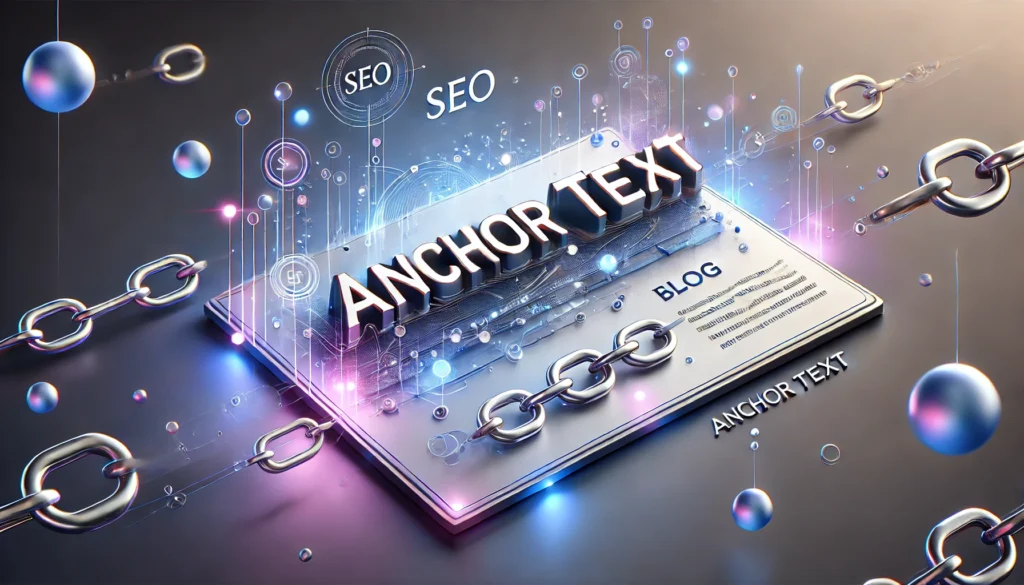
As the importance of optimizing a website for search engines continues to grow, anchor text has become an essential element in digital marketing.
Simply having a website is not enough for website owners – they must also ensure their website is optimized for search engines to rank high in SERPs and attract relevant traffic.
That’s why we’ve created this blog – to give you a complete understanding of anchor text and its role in SEO.
Whether you’re a website owner, marketer, or SEO professional, this blog will equip you with the knowledge to use anchor text effectively and improve your website’s search engine performance.
By the end of this blog, you should have a solid understanding of anchor text links and how to use them to improve your website’s SEO.
So, let’s dive in.
What Is Anchor Text?

Anchor text is the text that is used as a clickable link to navigate to another webpage. It is usually displayed differently than the surrounding text, often underlined and in a distinct color to signify that it is a hyperlink.
Users who click on it are taken to the linked page. It’s an essential aspect of SEO because search engines use it to understand the content and relevance of the linked page.
For example, if a blog post about digital marketing links to another post about social media marketing, the anchor text might say “social media marketing.”
This tells users and search engines that the linked page is about social media marketing, which can help improve its visibility in search engine results pages (SERPs).
Different Types Of Anchors
There are several anchors, each with characteristics and potential impact on SEO. Here are seven types of them:
Exact Match
It is when the hyperlink’s text matches the target page’s primary keyword or keyphrase.
For example, if the target page’s primary keyword is “best coffee makers,” the exact match would also say “best coffee makers.” While exact matches can be effective for SEO, they can also be overused and appear spammy.
Partial Match
Partial match includes the target page’s primary keyword, a key phrase, and other words.
For example, if the target page’s primary keyword is “best coffee makers,” the partial match anchor text could say, “find the best coffee makers here.” Partial match anchor text can be more natural and effective than exact match anchor text.
Branded
Branded text includes the name of the brand or company being linked to.
For example, if a website links to Coca-Cola’s website, the branded anchor text would say “Coca-Cola.” Branded anchor text can help build brand recognition and authority.
Naked URL
This type of anchor text uses the URL of the linked page as the text. For example, instead of using “best pizza in New York” as the anchor text, the URL “www.bestpizzanyc.com” would be used.
While this may not provide much context for users, it can be helpful in link building and promoting brand recognition.
Generic
Generic anchor text includes non-descriptive words such as “click here” or “read more.” While generic anchor text does not provide any information about the linked page, it can be helpful in some situations where the user does not need to know the linked page’s content.
Image Anchor
Image anchor text is when the hyperlink is embedded in an image. The text surrounding the image or in the image’s ALT tag can be used as the anchor text. Image anchor text can help link to visual content or make calls to action more visually appealing.
Co-Citation
Co-citation anchor text is when a hyperlink is embedded in a sentence referencing a third-party website or brand.
For example, if a blog post mentions Coca-Cola and links to a third-party article about soft drink ingredients, the anchor text could say “soft drink ingredients.” Co-citation anchor text can be effective for building relationships with other websites and demonstrating industry expertise.
Why Is Anchor Text Important for SEO?
Anchor text is important for SEO because it helps search engines and users understand the context and relevance of the linked content. Here’s why it matters:
1. Improves Keyword Relevance
Search engines analyze anchor text to determine the topic of the linked page. Using relevant keywords in anchor text can help improve the ranking of the linked page for those keywords.
2. Enhances User Experience
Well-structured anchor text gives users a clear idea of what to expect when they click a link, improving navigation and engagement.
3. Helps Search Engines Crawl and Index Pages
Anchor text helps search engine bots discover and index new pages by providing contextual clues about their content.
4. Impacts Link Equity (Page Authority)
Anchor text influences how link equity (also known as “link juice”) is distributed across a website, helping to strengthen the authority of linked pages.
5. Avoids Over-Optimization Penalties
Using too many keyword-rich anchors unnaturally can trigger Google’s spam filters. A mix of branded, generic, and partial-match anchor texts helps maintain a natural backlink profile.
6. Supports Internal Linking Strategy
Using descriptive anchor text in internal links improves website structure, making it easier for users and search engines to find related content.
7. Boosts Click-Through Rates (CTR)
A compelling anchor text encourages users to click on the link, increasing traffic and engagement.
For the best SEO results, it’s important to use diverse and natural-looking anchor text while ensuring it aligns with the linked content.
Anchor Text Optimization For SEO
Here are some best practices for optimizing anchor text for SEO:
Focus On Relevance And Context
The anchor should be relevant to the linked page’s content and provide additional context to the user.
For example, using the anchor “best-running shoes” for a link to a page about running shoes would be more relevant than using the anchor text “click here.”
Use A Mix Of Anchor Text Types
Using a mix of branded, generic, and long-tail keyword anchor text can help provide variety and avoid over-optimization.
Branded anchor text uses the brand name as the anchor text, while generic anchor text uses words such as “click here” or “read more.” Long-tail keyword anchor text uses longer, more specific phrases related to the content.
Avoid Over-Optimization
Over-optimization occurs when the exact anchor text is used excessively or unnaturally. Overusing exact match or partial match anchor text can appear spammy and lead to penalties from search engines. It’s essential to use various anchor texts and avoid appearing manipulative.
Use Internal Linking
Internal linking, or linking between pages within the same website, can improve the user experience and help search engines understand the website’s structure and hierarchy. Using descriptive anchor text for internal links can also provide context to search engines about the content of the linked pages.
Monitor And Analyze Performance
Monitoring the performance of anchor text links can help identify areas for improvement and adjust strategies accordingly. Analyzing metrics such as click-through rate (CTR) and conversion rate can provide insights into which anchor text types and strategies are working effectively.
Various tools available in the market can help with anchor text analysis, such as SEMrush and Ahrefs. You can select the tool that best suits your needs depending on your specific needs and requirements.
These tools can help you analyze your anchor text usage and make adjustments to improve your search engine rankings.
FAQs
Q1. How Many Anchor Text Links Should I Use On A Page?
A. There is no fixed number of anchors to use on a page. Using them only where it makes sense, and the context is relevant is recommended. Overuse of anchors can lead to over-optimization and penalties from search engines.
Q2. Can I Use The Same Anchor Text For Different Links On The Same Page?
A. It is best to avoid using the exact anchors for different links on the same page. It can appear spammy and lead to confusion for users and search engines. Using a mix of the relevant and diverse anchors is recommended.
Q3. Can I Change The Anchor Of An Existing Link?
A. Yes, you can change the anchor of an existing link, but it is essential to consider its impact on the website’s SEO performance. Changing anchor text too frequently can appear manipulative and lead to penalties from search engines.
Final thoughts
As of now, you might clearly understand what anchor text is and how it plays a crucial role in SEO.
If you still have any questions about the topic, then feel free to leave your questions in the comments section. We will be happy to answer you.
Thanks for reading 🙂


